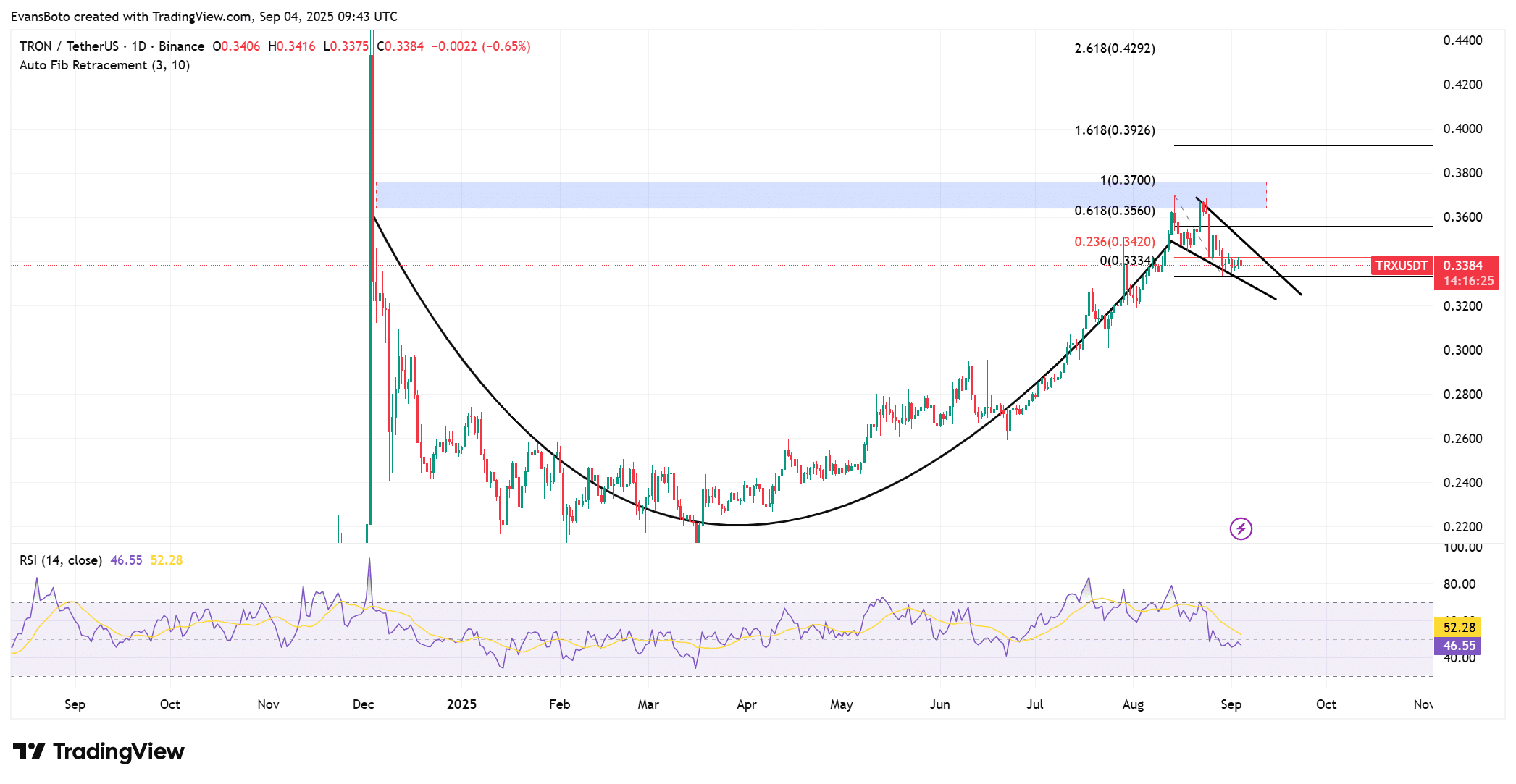Orca wallets dominated TRON USDT flows on Sept 4, capturing 52% and signaling exchange-bound liquidity and accumulation. Combined with negative funding rates and steady spot outflows, this creates a high-probability setup for a TRX short squeeze if bulls reclaim $0.37.
-
Orca wallets captured 52% of TRON USDT flows on Sept 4, 2025.
-
Spot outflows near $10M and mid-tier wallet accumulation reduced sell pressure.
-
Derivatives show negative OI-weighted funding, increasing short squeeze risk; TRX at $0.338.
TRX breakout signals: TRON USDT flows spike to 52%, fueling short squeeze potential — monitor $0.37 breakout for next move. Read analysis and trade considerations.
What drove Orca wallets to capture 52% of TRON USDT flows?
Orca wallet concentration reached 52% on Sept 4, 2025, reflecting coordinated movement of USDT on TRON into mid-tier custodial addresses. This front-loaded liquidity often precedes exchange positioning or accumulation, signaling that large actors could be preparing for market directional moves.
How did this compare to August peaks?
August saw a prior peak near 45%, which coincided with an 8% rally in Bitcoin afterward. The new 52% reading surpassed that level, suggesting a larger and faster shift of liquidity into strategic wallets. Historical patterns show such concentration frequently aligns with compressed volatility resolving higher.
Key Takeaways
Orca wallets capture 52% of TRON USDT flows, signaling liquidity preparation. Spot outflows and bearish Funding Rates hint at short squeeze potential.
Orca wallets surged to dominate TRON’s USDT activity, capturing 52% of flows on the 4th of September, a record high.
This exceeded the previous 45% peak in August, which was followed by an 8% Bitcoin rally. Historically, such behavior is tied to liquidity shifts into exchanges, often preceding market expansions.
TRON’s deep reliance on USDT makes this data even more relevant. TRX traded at $0.338 at press time, after recent consolidation.
With mid-tier wallets driving liquidity, analysts see a potential setup for broader market positioning that could trigger TRX strength in the coming sessions.
Can TRX break past $0.37?
TRX shows bullish technical structures that point to a possible breakout above $0.37 if buyers reclaim the neckline. A confirmed breakout would open Fibonacci targets near $0.39 and $0.42.
The daily chart formed a clear cup-and-handle pattern with the neckline in a resistance zone between $0.356 and $0.37. A falling wedge also supports upside resolution when demand picks up.
RSI sits near 46, indicating neutral momentum that could expand if buying pressure increases. Bulls should watch volume and neckline retest for confirmation.

Source: TradingView
Why do exchange flows matter for TRX’s next move?
Exchange flows reveal supply-side pressure and accumulation trends. On Sept 4, TRX recorded nearly $10 million in net outflows, reinforcing steady accumulation and reducing immediate sell-side liquidity.
When assets move into cold storage or custodial wallets, short-term sell pressure declines. That can create asymmetric upside risk if derivatives carry bearish positioning.
If accumulation continues, it will strengthen buy-side conviction and increase the odds of a decisive breakout above critical resistance.

Source: CoinGlass
How does derivatives positioning affect TRX?
Negative OI-weighted funding indicates short dominance, which increases the probability of a short squeeze if spot demand accelerates. Negative funding plus heavy spot outflows creates a setup for forced short covering.
Historically, negative funding paired with strong spot flows has triggered rapid upside moves. Bears may become vulnerable if accumulation sustains and technical resistance breaks.

Source: CoinGlass
Is TRX preparing for a decisive breakout?
Yes — current on-chain and technical indicators point to a high-probability test of $0.37. Orca wallet dominance, consistent spot outflows, and bullish chart patterns create a constructive bias, while negative funding rates increase the chance of rapid upside on a breakout.
Traders should monitor neckline reclaim, volume expansion, and continued outflows to validate a sustainable move higher.
Frequently Asked Questions
How did Orca wallets reach 52% of TRON USDT flows?
Mid-tier custodial wallets increased USDT inflows on TRON, concentrating liquidity and signaling potential exchange positioning or long-term accumulation. This shift was measured on-chain using wallet flow analytics.
What is the significance of negative funding rates for TRX?
Negative funding rates show short trader dominance in derivatives markets. If spot buying accelerates, short positions can be forced to cover quickly, producing sharp upward price moves.
How-to: Interpret TRX on-chain and technical signals
- Monitor wallet concentration: Check Orca and mid-tier wallet flows for sudden spikes in USDT movement.
- Watch exchange flows: Net outflows suggest accumulation; inflows indicate sell pressure.
- Check derivatives: Negative funding increases short squeeze risk; positive funding signals long dominance.
- Confirm with price action: Look for neckline reclaim, volume surge, and RSI expansion to validate breakouts.
Key Takeaways
- Orca dominance: 52% TRON USDT flows signal major liquidity concentration into mid-tier wallets.
- Accumulation: Nearly $10M net outflows point to steady accumulation and lower immediate sell pressure.
- Short-squeeze risk: Negative funding combined with spot accumulation increases the odds of rapid upside if $0.37 breaks.
Conclusion
Orca wallet dominance, consistent exchange outflows, and bullish technical patterns create a compelling case that TRX is positioned for a decisive test of $0.37. Traders should watch neckline reclaim, volume, and funding dynamics closely. COINOTAG will monitor on-chain flows and derivatives for updates and follow-up analysis.
